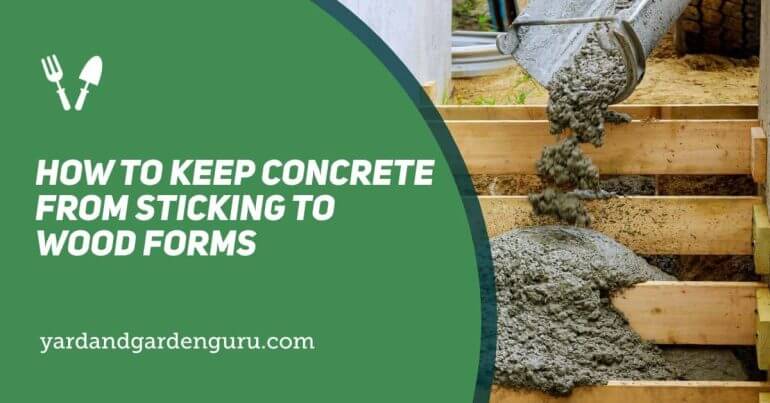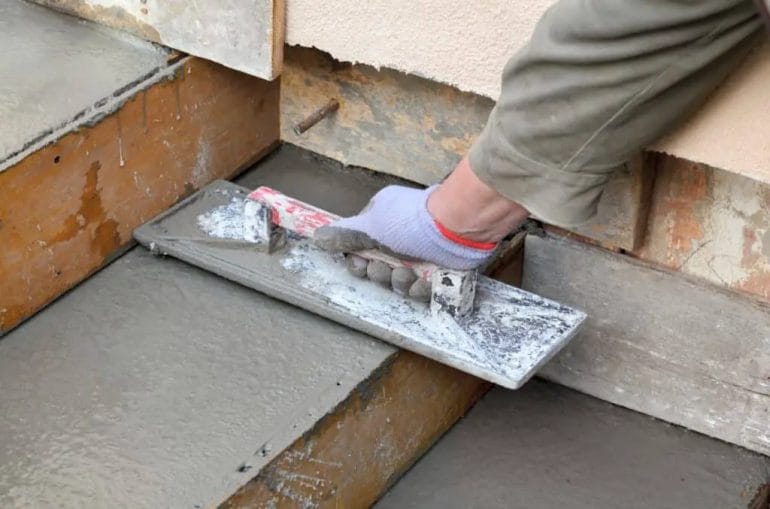Are you tired of dealing with the hassle of concrete sticking to your wood forms? Whether you are a DIY enthusiast or a professional contractor, finding a solution to this problem is crucial for achieving seamless, smooth concrete surfaces. In this article, we will explore some effective techniques and tips to prevent concrete from sticking to wood forms. By implementing these methods, you can ensure clean and easy form removal while saving time and effort on your construction projects.
One of the key factors in preventing concrete from sticking to wood forms is proper form preparation. Applying a form release agent is essential in creating a barrier between the wood surface and the concrete. This release agent can be in the form of a liquid, spray, or even a wax-based compound. By generously applying the release agent to the wood forms, you can minimize adhesion and make the concrete removal process much smoother.

In addition to using form release agents, another effective technique is to use plastic or metal form liners. These liners are designed to fit inside the wood forms, providing a non-stick surface for the concrete to cure against. Not only do they prevent sticking, but they also create interesting textures and patterns on the finished concrete surface, enhancing its aesthetic appeal.
Furthermore, ensuring that the wood forms are smooth and free from any rough edges or splinters is crucial in preventing concrete adhesion. Sanding down the wood surfaces and applying a sealant or primer can help create a smoother finish, reducing

2. Preparing Wood Forms: Key Steps to Prevent Concrete Adhesion
When it comes to working with concrete, properly preparing the wood forms is crucial to ensure a successful project. One of the main challenges in working with wood forms is preventing the concrete from adhering to the surface. Concrete adhesion can cause issues such as difficulty in removing the forms, rough finishes, and even damage to the wood. To prevent concrete adhesion, there are key steps that need to be followed during the preparation of wood forms.
2.1 Cleaning the Surface
The first step in preparing wood forms is to thoroughly clean the surface. Any dirt, dust, or debris on the wood can create a barrier between the form and the concrete, leading to adhesion. Start by using a stiff bristle brush to remove any loose particles from the surface. Next, use a mild detergent mixed with water to scrub away any stubborn stains or residues. Rinse the forms with clean water and allow them to dry completely before proceeding to the next step.
2.2 Applying a Release Agent
Applying a release agent is an effective way to prevent concrete adhesion to wood forms. A release agent forms a barrier between the wood and the concrete, allowing for easy removal of the forms once the concrete has cured. There are different types of release agents available, such as form oils, form sprays, and form pastes. Choose a release agent that is compatible with the type of wood and concrete being used. Apply the release agent evenly to the entire surface of the wood forms, making sure to cover all areas that will come in contact with the concrete.
2.3 Using Form Liners
In addition to using a release agent, using form liners can also help prevent concrete adhesion. Form liners are flexible sheets made of materials such as plastic or rubber that are placed inside the wood forms. These liners create a textured surface on the concrete, giving it a desired finish while preventing adhesion. Form liners are available in various patterns and designs, allowing for customization of the concrete surface. Before using form liners, make sure they are clean and free from any residues that could affect their performance.
2.4 Treating the Wood
Treating the wood forms can further enhance their resistance to concrete adhesion. One common treatment method is the application of a form release agent or a wood sealer. Form release agents are specifically designed to prevent adhesion and can be applied to the wood surface before each use. Wood sealers, on the other hand, create a protective layer that helps repel moisture and prevent the wood from absorbing water from the concrete. Applying a form release agent or wood sealer according to the manufacturer’s instructions can significantly reduce the risk of concrete adhesion.
2.5 Proper Form Removal
After the concrete has cured, it is important to follow proper form removal techniques to minimize the chances of concrete adhesion. Start by carefully inspecting the forms to ensure that the concrete has fully hardened and is ready for removal. Use pry bars or rubber mallets to gently separate the forms from the concrete, taking care not to damage the concrete surface. Avoid using excessive force or sharp tools that could scratch or chip the concrete. If there are any stubborn areas of adhesion, lightly sand or use a wire brush to remove them.
In summary, preventing concrete adhesion to wood forms is essential for successful concrete projects. By following key steps such as cleaning the surface, applying a release agent, using form liners, treating the wood, and practicing proper form removal techniques, you can ensure that your wood forms are well-prepared and that the concrete will easily separate from the forms, resulting in a smooth and professional finish.

Essential Tools and Techniques for Preventing Concrete from Sticking to Wood Forms
When working with concrete, one of the common challenges is preventing it from sticking to wood forms. This can cause issues with the final finish and make it difficult to remove the forms without damaging the concrete. However, with the right tools and techniques, you can ensure a smooth and successful concrete pour. In this section, we will discuss some essential tools and techniques for preventing concrete from sticking to wood forms.
1. Release Agents
One of the most effective ways to prevent concrete from sticking to wood forms is by using release agents. These are substances that create a barrier between the concrete and the wood, making it easier to remove the forms once the concrete has cured. There are different types of release agents available, such as form oils, form sprays, and form wax. It is important to select a release agent that is compatible with both the wood and the concrete being used.
2. Proper Form Preparation
Before pouring concrete, it is essential to properly prepare the wood forms to minimize the chances of sticking. This includes cleaning the forms thoroughly to remove any dirt, debris, or previous concrete residue. It is also important to apply a thin layer of release agent to the inside surfaces of the forms. This will create a smooth surface and help prevent adhesion between the concrete and the wood.
3. Use of Plastic or Nylon Liners
In some cases, using plastic or nylon liners on the inside surfaces of the wood forms can be an effective solution to prevent concrete from sticking. These liners create a physical barrier between the concrete and the wood, reducing the chances of adhesion. Additionally, liners can help create a smoother finish on the concrete and make it easier to remove the forms.
4. Proper Concrete Consistency
The consistency of the concrete itself plays a crucial role in preventing sticking. If the concrete is too dry, it can cause friction and increase the chances of adhesion to the wood forms. On the other hand, if the concrete is too wet, it can seep into the wood and make it difficult to remove the forms. It is important to follow the recommended mix ratios and ensure that the concrete has the right consistency for the specific project.
5. Vibrating the Concrete
Using a concrete vibrator during the pouring process can help minimize the chances of sticking. The vibrations help the concrete settle and fill any air voids or gaps between the concrete and the wood forms. This reduces the risk of adhesion and ensures a smooth and even finish.
6. Proper Curing
After the concrete has been poured and the forms have been removed, it is important to properly cure the concrete to prevent any future sticking. This involves keeping the concrete moist and protected from extreme temperatures for a certain period of time. Proper curing helps the concrete reach its full strength and reduces the chances of adhesion to any surrounding surfaces.
In summary, preventing concrete from sticking to wood forms requires the use of essential tools and techniques. This includes using release agents, properly preparing the forms, using liners if necessary, ensuring the right concrete consistency, vibrating the concrete, and properly curing the finished product. By following these guidelines, you can ensure a successful concrete pour with minimal sticking and achieve a professional and smooth finish.

Choosing the Right Formwork Material: Minimizing the Risk of Concrete Sticking
When it comes to constructing concrete structures, one of the key challenges is ensuring that the concrete does not stick to the formwork. Concrete sticking can lead to a range of issues, including surface imperfections and difficulties in removing the formwork once the concrete has cured. To minimize these risks, it is essential to choose the right formwork material. In this section, we will discuss the importance of selecting the appropriate formwork material and explore some of the options available.
The Importance of Choosing the Right Formwork Material
The choice of formwork material plays a significant role in determining the quality of the finished concrete structure. The formwork material directly affects the surface finish, dimensional accuracy, and ease of formwork removal. If the wrong material is selected, it can result in challenges during construction and additional costs to rectify any defects.
One major concern when it comes to formwork is the risk of concrete sticking to the surface. When concrete sticks to the formwork, it can be difficult to achieve a smooth and uniform finish. Additionally, removing the formwork becomes a challenging task, potentially leading to damage to the concrete structure.
Factors to Consider when Choosing Formwork Material
When selecting formwork material, there are several factors to consider to minimize the risk of concrete sticking:
- Release Agents: Choose a formwork material that is compatible with effective release agents. Release agents create a barrier between the formwork and the concrete, preventing sticking. The choice of release agent depends on the type of formwork material being used.
- Smooth Surface: Opt for a formwork material with a smooth surface. Smooth surfaces minimize the adhesion between the formwork and the concrete, reducing the risk of sticking.
- Low Absorption: Formwork materials with low absorption properties are less likely to absorb moisture from the concrete, reducing the risk of sticking. Materials such as steel, glass-fiber-reinforced polymer (GFRP), and high-density plastic have low absorption rates.
- Temperature Resistance: Consider the temperature conditions during construction. Some formwork materials may be more prone to sticking at higher temperatures. Choose a material that can withstand the expected temperature conditions without compromising its performance.
- Durability: Formwork materials should be durable enough to withstand the pressures and forces exerted by the concrete during pouring and curing. Choosing a strong and sturdy material will minimize the risk of damage and improve the overall quality of the finished structure.
Formwork Material Options
There are various formwork materials available, each with its own set of advantages and disadvantages. The choice of material depends on the specific requirements of the project. Some common formwork materials include:
| Material | Advantages | Disadvantages |
|---|---|---|
| Timber | Cost-effective, easily available | Prone to warping and swelling, requires frequent maintenance |
| Steel | Durable, reusable, provides a smooth surface finish | Expensive, requires skilled labor for installation and removal |
| Aluminum | Lightweight, easy to handle, corrosion-resistant | Relatively expensive, limited load-bearing capacity |
| Glass-Fiber-Reinforced Polymer (GFRP) | High strength, corrosion-resistant, low absorption | Expensive, limited availability |
| Plastic | Lightweight, low absorption, reusable | Lower load-bearing capacity compared to other materials |
It is important to assess the requirements of the project, considering factors such as budget, desired finish, and ease of installation and removal, before selecting the appropriate formwork material.
Choosing the right formwork material is crucial for minimizing the risk of concrete sticking and ensuring the
Troubleshooting Tips: How to Remove Concrete Stuck to Wood Forms
Concrete is a versatile and durable material commonly used in construction projects. When pouring concrete, wooden forms are often used to shape the structure. However, one common issue that can arise is concrete sticking to the wood forms. This can be a frustrating problem that requires careful removal to avoid damaging the wood. In this section, we will provide you with troubleshooting tips on how to effectively remove concrete that has become stuck to wood forms.
1. Allow the Concrete to Cure
Before attempting to remove the concrete from the wood forms, it is important to allow the concrete to fully cure. Curing refers to the process of maintaining the moisture content and temperature of the concrete to ensure proper strength development. Typically, concrete takes around 28 days to fully cure. Attempting to remove the concrete before it has cured can result in damage to the wood forms.
2. Use a Release Agent
A release agent is a substance that can be applied to the wood forms before pouring the concrete. It creates a barrier between the concrete and the wood, preventing them from sticking together. There are different types of release agents available, including oil-based or wax-based options. Before using a release agent, make sure to read and follow the manufacturer’s instructions carefully.
3. Apply Heat
If the concrete has already dried and adhered to the wood forms, applying heat can help soften the concrete, making it easier to remove. You can use a heat gun or a blowtorch to carefully heat the affected areas. Be cautious not to overheat the wood, as excessive heat can cause damage. Once the concrete has softened, you can use a scraper or a putty knife to gently remove it from the wood.
4. Use Mechanical Methods
If the concrete is firmly stuck to the wood forms and cannot be easily removed with heat or scraping, mechanical methods can be employed. One option is to use a chisel or a hammer and chisel to carefully chip away at the concrete. Take care not to apply excessive force, as this can damage the wood. Another mechanical method is to use a power washer with a high-pressure nozzle to dislodge the concrete. This method should be done with caution to avoid splintering the wood.
5. Sand or Grind the Surface
If there are residual concrete or stubborn patches remaining on the wood forms, sanding or grinding the surface can help remove them. Start with a coarse grit sandpaper or grinding wheel and gradually move to finer grits until the surface is smooth. Take care to wear protective goggles and a mask to prevent inhaling dust particles.
In summary, removing concrete that is stuck to wood forms requires patience and careful execution. It is important to allow the concrete to fully cure before attempting removal and to use a release agent to prevent sticking in the first place. If the concrete has already hardened, applying heat, using mechanical methods, or sanding and grinding can help effectively remove the concrete from the wood. By following these troubleshooting tips, you can safely remove concrete from wood forms without causing damage.
FAQs
How can I prevent concrete from sticking to wood forms?
To keep concrete from sticking to wood forms, you can apply a release agent such as form oil or a non-stick spray. Make sure to coat the interior surface of the form with a thin layer before pouring the concrete. Additionally, using plastic or plywood form boards instead of bare wood can also help prevent sticking.
Conclusion:
In conclusion, preventing concrete from sticking to wood forms is crucial for efficient and successful construction projects. By applying suitable release agents like form oils, sprays, or paste wax, you can create a protective barrier between the concrete and the wood. Additionally, using plastic sheeting or parchment paper can further minimize adhesion. Properly cleaning and treating the wooden forms before each use also plays a significant role in preventing sticking. Regular inspection and maintenance of the forms can help identify any potential issues and ensure their longevity. By implementing these preventive measures, you can greatly reduce the risk of concrete sticking to wood forms, resulting in smoother and more professional construction projects.